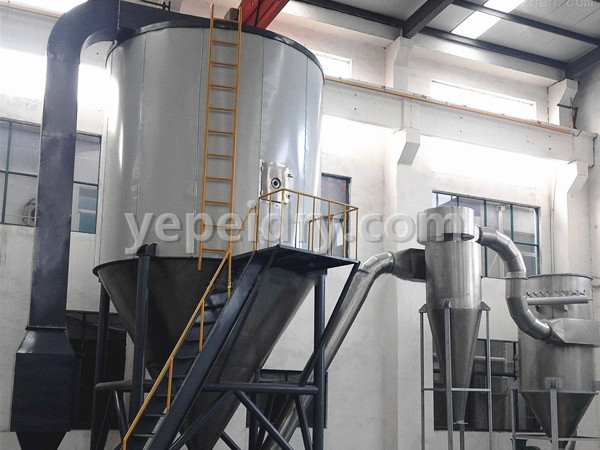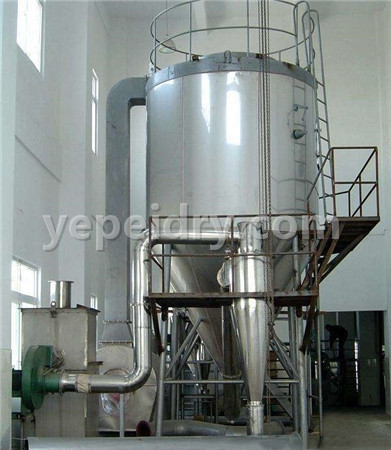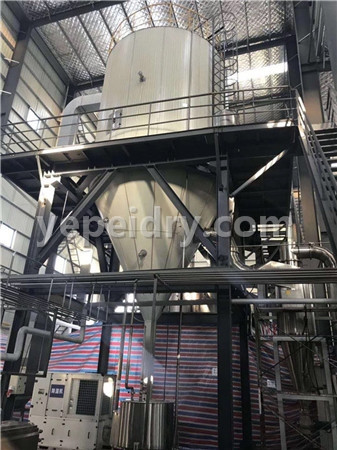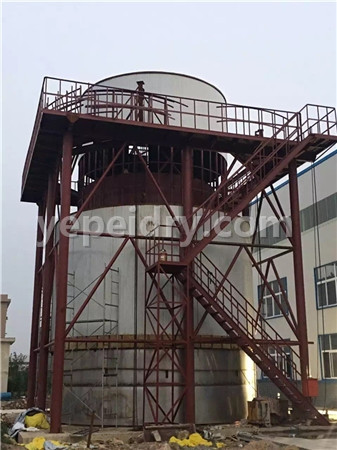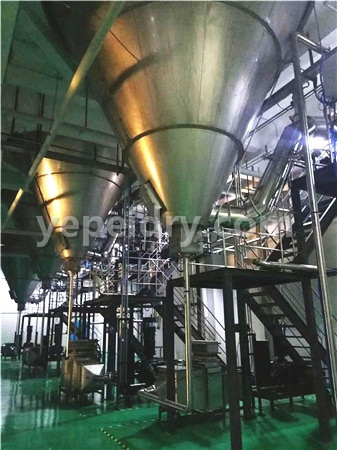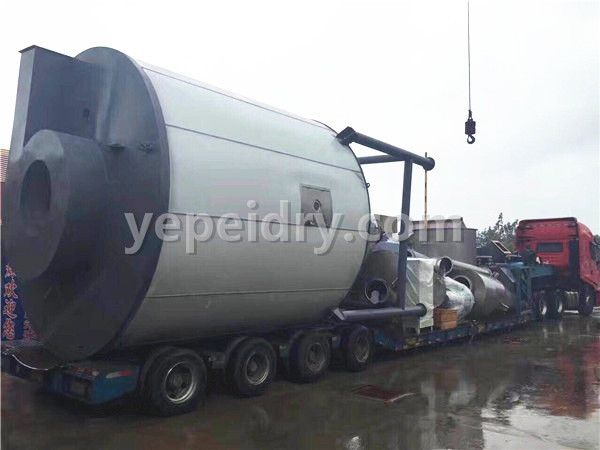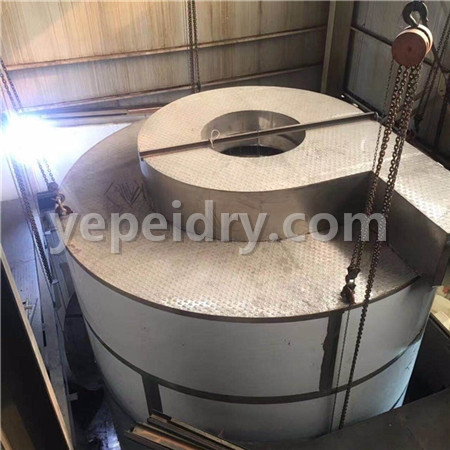- Drying Equipment
- Granulation equipment
- Mixed equipment
- Crushing equipment
- Screening equipment
- Heat Source Equipment
- Auxiliary equipment
Drying Equipment > Spray drying
Product Details
Related Projects
Product introduction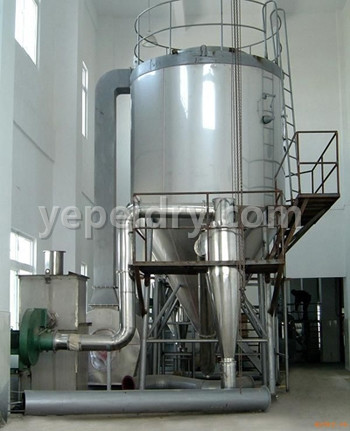
Spray drying is a process used in liquid forming and drying industry. It is suitable for producing powdery and granular solid products from solution, emulsion, suspension and paste liquid raw materials. Therefore, spray drying is an ideal process when the particle size distribution, residual water content, bulk density and particle shape of finished products must meet precise standards.
Working principle
The air is filtered and heated and enters the air distributor at the top of the dryer. The hot air enters the drying chamber spirally and evenly. The high speed centrifugal atomizer at the top of the tower (swivel) is atomized into tiny droplets of mist, contacting with the hot air and flowing into the finished product in a very short time. The finished product is continuously exported from the bottom of the drying tower and the cyclone separator, and the exhaust gas is exhausted by the fan.
Performance characteristics
◎The drying speed is fast, and the surface area of material and liquid is greatly increased after atomization. In hot air flow, 95% - 98% of water can be evaporated instantaneously. The drying time is only a few seconds. It is especially suitable for drying heat sensitive materials.
◎The product has good uniformity, fluidity and solubility, high purity and good quality.
◎The production process is simplified and the operation and control are convenient. For the liquid containing 40-60% moisture (90% of special materials), it can be dried into powder products at one time without crushing and screening after drying, which can reduce the production process and improve the product purity. The particle size, bulk density and moisture of the product can be adjusted by changing the operating conditions in a certain range, so the control and management are very convenient.

Material adaptation
Chemical industry: sodium fluoride (potassium), basic dye pigments, dye intermediates, compound fertilizers, formaldehyde silicic acid, catalysts, sulfuric acid, amino acids, silica, etc.
Plastic resin: AB, ABS emulsion, urea formaldehyde resin, phenolic resin, rubber (urea) formaldehyde resin, polyethylene, polyvinyl chloride and so on.
Food industry: fat-rich milk powder, gelatin, cocoa milk powder, milk substitute powder, blood powder, egg white (yellow) and so on.
Food and plants: oats, chicken juice, coffee, instant tea, spiced meat, protein, soybean, peanut protein, hydrolysate, etc.
Sugars: corn syrup, corn starch, glucose, pectin, maltose, potassium sorbate, etc.
Ceramics: alumina, ceramic tile materials, magnesium oxide, talc powder, etc.

technical specifications
|
Model Items/parameters |
5 | 25 | 50 | 150 | 200-2000 |
| Inlet temperature | 140-350 automatic control | ||||
| outlet temperature | 80-90 | ||||
| Maximum evaporation of water(kg/h) | 5 | 25 | 50 | 150 | 200-2000 |
| Drive form of centrifugal spray head | Compressed air drive | mechanical drive | |||
| Maximum speed(r.p.m) | 25000 | 18000 | 18000 | 15000 | 8000-15000 |
| Diameter of spray tray(mm) | 50 | 120 | 120 | 150 | 180-240 |
| heat source | electric | Steam + electricity | Steam + Electricity, Fuel Oil, Gas, Hot Blast Furnace | ||
| Maximum power of electric heating(kw) | 9 | 36 | 72 | 99 | |
| Outward Dimensions (Length, Width, Height)(m) | 1.8×0.93×2.2 | 3×2.7×4.26 | 3.5×3.5×4.8 | 5.5×4×7 | Determine according to the actual situation |
| Dry powder recovery(%) | ≥95 | ||||
Note: Water evaporation is related to material characteristics, hot air intake and outlet temperature. When the outlet temperature is 90 < sup > O C, the water evaporation curve is shown in the figure above (for reference). With the product updating, the relevant parameters are changed without prior notice.

Instructions for Order
◎Name and physical properties of material and liquid: solid content (or water content), viscosity, surface tension, PH value.
◎After drying, powder capacity, allowable residual water content, particle size, allowable maximum temperature.
◎Output, daily shift time.
◎Energy supply: steam pressure, capacitance, coal, oil and gas.
◎Control requirements: whether the inlet and outlet temperatures need to be self-controlled.
◎Pulverizing requirements: Whether to install bag traps, environmental requirements for exhaust emissions.
◎Other special requirements.
technical specifications
| size | A | B | C | D | E1 | E2 | F | G | H | I |
| LPG-25 | 1290 | 3410 | 4260 | 1800 | 1200 | 1200 | 1000 | 1700 | 1300 | 1550 |
| LPG-50 | 1730 | 4245 | 5100 | 2133 | 1640 | 1640 | 1250 | 1750 | 1800 | 1600 |
| LPG-100 | 2500 | 5300 | 6000 | 2560 | 2100 | 2100 | 1750 | 1930 | 2600 | 1780 |
| LPG-150 | 2800 | 6000 | 7000 | 2860 | 2180 | 2180 | 1970 | 2080 | 3050 | 1960 |
| LPG-200 | 2800 | 6600 | 7300 | 3200 | 2300 | 2300 | 2210 | 2250 | 3050 | 2100 |
| LPG-300 | 2800 | 8000 | 8700 | 3700 | 2800 | 2800 | 2520 | 2400 | 3040 | 2250 |
Last:Period
Copyright © 2018 Changzhou Yepei Drying Engineering Co., Ltd.
Technical support:Changzhou wisdom cubic network technology co., LTD
Technical support:Changzhou wisdom cubic network technology co., LTD

